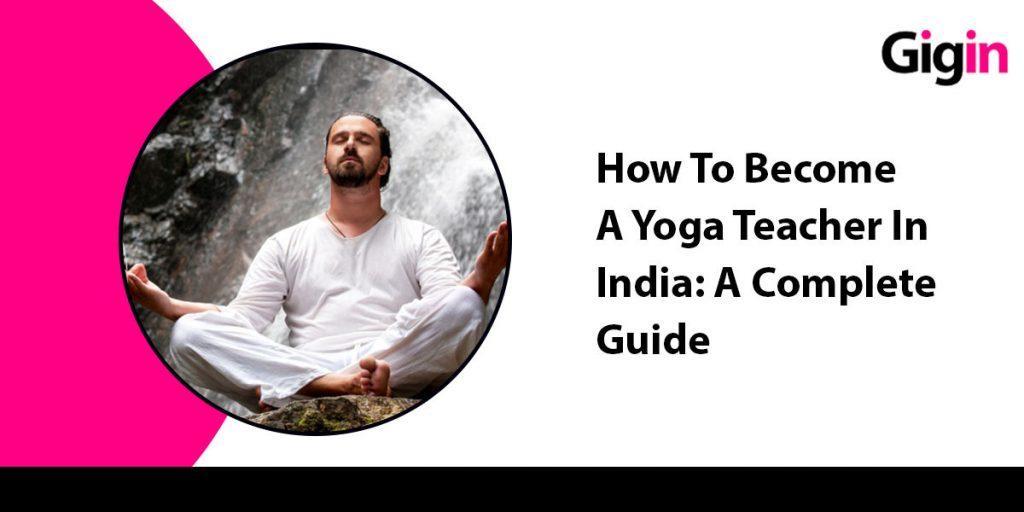Yoga is a spiritual activity practiced for thousands of years in Indian culture. Unsurprisingly, India is a popular location for yoga teacher training (YTT) programs. Being a yoga instructor in India allows you to not only enhance your understanding of yoga but also to immerse yourself in the country’s rich culture and spiritual tradition. Nevertheless, with so many YTT programs, it might be challenging to know where to begin.
This comprehensive guide will teach you all you need to know to become a certified yoga teacher in India. This guide covers everything from learning the fundamentals of yoga to selecting the best YTT school and launching your teaching career. So, let us embark on this fantastic adventure of self-discovery and enlightenment!

Understanding the Fundamentals
Before becoming a yoga teacher in India, learning the fundamentals of yoga and yoga teacher training is critical.
Yoga is an ancient Indian spiritual and physical discipline. It combines postures (asanas), breathing methods (pranayama), and meditation to enhance physical and mental well-being. There are numerous yoga styles, including Hatha, Ashtanga, Vinyasa, Iyengar, and Kundalini, each with its focus and method.
A yoga teacher training (YTT) program is a must to become a certified yoga teacher. These programs typically last 200 to 500 hours and can be completed in one month to many months. Yoga philosophy, anatomy and physiology, teaching methods, and practicum are all topics included in YTT programs (teaching practice).
Comprehending the distinction between YTT and yoga alliance certification is critical. The Yoga Alliance is a non-profit organization that establishes guidelines for yoga teacher training and certification. While finishing a YTT program is required for yoga alliance certification, not all YTT programs are certified by the yoga alliance. Completing a registered yoga teacher (RYT) program, which includes additional requirements such as teaching hours and continuous education, is required for yoga alliance certification.
Finally, to be accepted for YTT programs in India, you must generally have some prior yoga experience. Some programs demand six months to a year of consistent yoga practice, while others may require more. Language requirements, such as fluency in English or Hindi, may also apply to some YTT programs.

Choosing a YTT Program in India
Selecting India’s best yoga teacher training (YTT) program is critical for a rewarding and successful experience. Here are some of few things to think about when choosing a YTT program:
- Location: India is a big country with numerous areas, each with its own culture and environment. Determine whether the YTT program is in a city, a rural area, or a retreat center. Consider your tastes and the type of atmosphere most favorable to your learning.
- Duration: YTT programs in India can last from one to several months. Think about how much time you can invest in the program and how long you want to stay in India.
- Seek YTT programs with a thorough curriculum that covers all areas of yoga, such as philosophy, anatomy, teaching methods, and practicum. Check if the program covers the type of yoga you want to teach.
- While not all YTT programs are yoga alliance accredited, selecting one that can provide you with added credibility and recognition as a yoga teacher.
- Cost: YTT programs in India can be inexpensive or expensive. Assess your budget and whether or not the program expenses include lodging and meals.
- Reviews: Read reviews and testimonials from prior students to get a sense of the YTT program’s quality and other students’ experiences.
- Teachers: Assess the qualifications and experience of the YTT program’s teachers. Seek teachers who are knowledgeable about yoga and enthusiastic about teaching.
Applying for a YTT Program in India
Begin by researching and shortlisting yoga teacher training (YTT) programs in India based on location, duration, curriculum, accreditation, pricing, reviews, and teachers. Once you’ve chosen the programs that interest you, visit their websites to learn more about their prerequisites and application procedure.
In most cases, applicants to YTT programs in India must submit an application form, a resume, a statement of intent, and a verification of past yoga practice. Some programs may also require a recommendation letter or an interview. Ensure you thoroughly read and follow the application requirements and submit all essential documents by the deadline.
You may have to wait for some weeks after completing your application before hearing back from the program. If accepted, you will usually be required to pay a deposit to confirm your place in the program. Specific YTT programs may also require you to obtain a visa to travel to India, so verify the visa requirements and give plenty of time for the application procedure.

Completing YTT in India
Attending a yoga teacher training (YTT) program in India can transform your life. Following completion of your YTT program, you should perform the following steps:
- If your YTT program is Yoga Alliance accredited, you will receive a certificate upon completion. Keep this certificate secure since it is your proof of yoga teacher certification.
- Practice: After finishing your YTT program, continue practicing yoga regularly to further your knowledge and skills. Take different seminars or advanced training to supplement your education.
- Teaching: After you feel prepared, begin teaching yoga classes to gain experience and confidence. Consider teaching classes to friends and family or volunteering at a community center or studio.
- Attend yoga conferences, workshops, and events to expand your network. Connect with other yoga teachers and industry professionals to learn from their experiences and possibilities.
After YTT: Building Your Yoga Teaching Career in India
Building your teaching career after completing a yoga teacher training (YTT) program in India requires dedication, hard work, and networking. Here are a some of few pointers to get you started:
- Get teaching experience by teaching friends, family members, or coworkers. To obtain different teaching experiences, consider volunteering at a community center or a studio.
- Create your brand: Create a robust online presence by developing a website or social media profile highlighting your abilities and teaching style. Create a logo and business cards to help promote your brand.
- Network: Attend yoga conferences, workshops, and events to network with other yoga professionals. Consider joining a yoga association or professional group to stay current on industry news and opportunities.
- Continued education: Attend advanced training, workshops, and continuing education courses to stay up to date on the latest advances in the yoga industry. Try specializing in a specific style or aspect of yoga to set yourself apart from other teachers.
- Promote your classes using local classifieds, flyers, or word-of-mouth. To attract new students, consider offering special deals or discounts.
You can develop a successful and rewarding career as a yoga teacher in India by following these steps and remaining committed to your yoga teaching career. Always try to share yoga’s advantages with your students while being loyal to your principles and teaching style.
Download the GIGIN App to get your favorite jobs in India.
Read Also: 5 Benefits Of Doing Part Time Jobs



